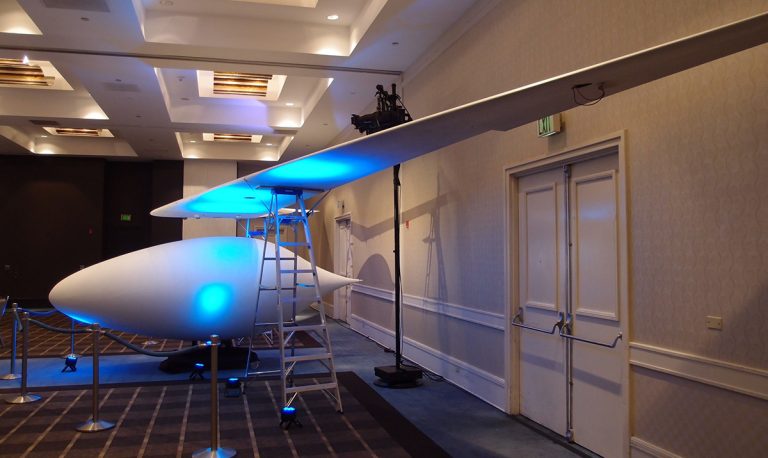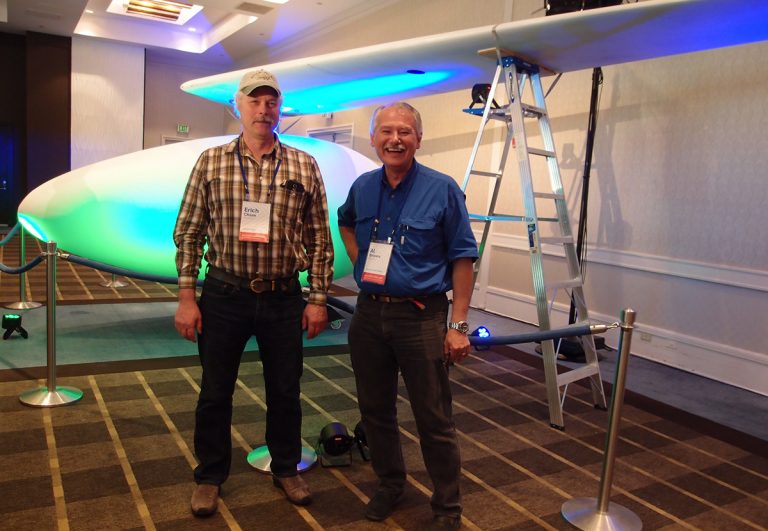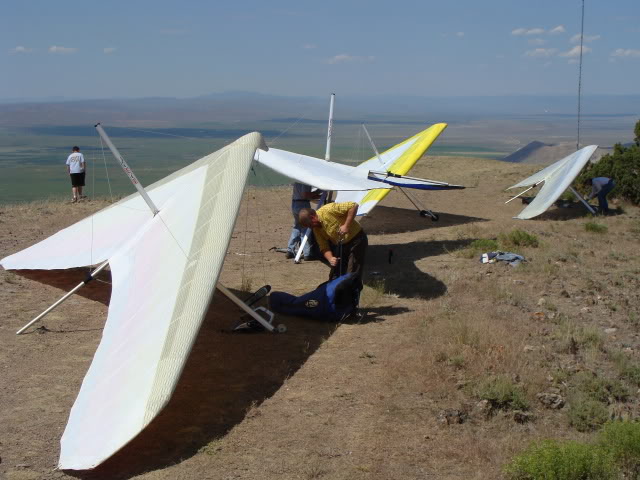Prandtl Wing, Goldschmied Fuselage
Posted on April 24, 2017, 11:20 pm, by Dean Sigler, under News.
 A Stunning Sight at the Sustainable Aviation Symposium
A Stunning Sight at the Sustainable Aviation Symposium
Attendees at the 2017 Sustainable Aviation Symposium (held in San Francisco, California) could be forgiven their startle reactions when they confronted a science-fiction like scene at one end of the hall, washed in blue and green lights. A 50-foot wing suspended over a large, cleanly streamlined body was at once exciting and puzzling. What were these geometric shapes? Why weren't they connected? If they represent a future flying machine, how will it be powered?
The Wing
The wing designed by Al Bowers, Chief Scientist at NASA Armstrong Flight Research Center, and built by Erich Chase, a master boat builder from Petaluma, represented Al's persistent attempts to gain recognition for a different approach to wing lift distribution espoused by Ludwig Prandtl, a NACA aerodynamicist in the 1920's and '30's. Prandtl thought lift should rise in the center of the wing span, then gracefully fall away by about 2/3 of the way toward the wing tip, tapering to nothing at the tip itself. This describes a bell-shaped lift distribution curve, considerably different from the elliptical lift distribution almost all aerodynamic texts describe as most ideal.
Al studied Prandtl and determined that following his theories led to extreme twist at the wingtip, 12 degrees or more. A conventional wing can have from none to about five degrees. This added twist, according to Al, provides proverse yaw - the wing wants to turn in the direction of bank. Pilots flying conventional airplanes tussle with adverse yaw, the tendency of the outside wing to pull the airplane out of the turn. Al says this is why birds don't need vertical tails - evidence that Prandtl was right. Al guided NASA interns who built several flying wings of up to 25-foot span and demonstrated their ability to fly as predicted.
Chase built a 50-foot version of the wing and brought it to the Western Workshop of the Experimental Soaring Association last Labor Day at Tehachapi, California. The wing, at that point, had no structure to accommodate a pilot. Erich fixed that with a rudimentary seat arrangement, which was test flown for eight flights by Steve Davy. According to Chase and the video shown during Al' presentation, the wing is extremely stable in pitch and yaw. With a reasonable fairing to streamline the pilot, similar to a Swift, the L/D might be over 30:1.
The Goldschmeid Fuselage
With the type of fairing shown at the SAS, a seemingly incongruous, bulbous teardrop, the performance would be even higher. Brien Seeley, President of the Sustainable Aviation Foundation, somehow talked his wife Anne, sons Damon and Tim, Tim's girlfriend Cheryl Jenkins, and board members Wayne Cook and his wife Liz, into constructing a Goldschmeid body fuselage that would seat two side-by-side. The team worked six weeks, day and night to finish by symposium time. Crafting a huge female mold in halves, with plywood formers and long foam strips cut from 4×8-foot blocks of foam that were then attached to the formers, the crew applied fiberglass cloth and resin to the molds to get the proper shape. The pulled sides were assembled with some interior structure to help stabilize the form for display purposes.
In actual use, according to a talk given by Wayne Cook, the fuselage would be attached to the wing by a single pylon, very much like the pylon that holds the wing above Erick Raymond's Sunseeker Duo. Two large multi-blade propellers would turn slowly and quietly for propulsion on this electric commuter - or cargo ship. The combination of a low-drag wing and revolutionary low-drag fuselage would mean economical transport.
Going full tilt on laminar flow, the fuselage would have no openings forward of the first two-thirds of its length. Passengers would be seated on a cart-like carriage that would be rolled into the forward part of the plane, with the rear fairing closed behind them. That would place them before a panoramic windscreen. When they landed, the cart on which they are seated could power them to the nearby ground destination, avoiding the trouble of having to call a cab or Uber.
This highly creative combination of academic and physical discipline resulted in a stunning display that set attendees' minds in a properly aspirational direction.
 Erich Chase and Al Bowers
Erich Chase and Al Bowers 

